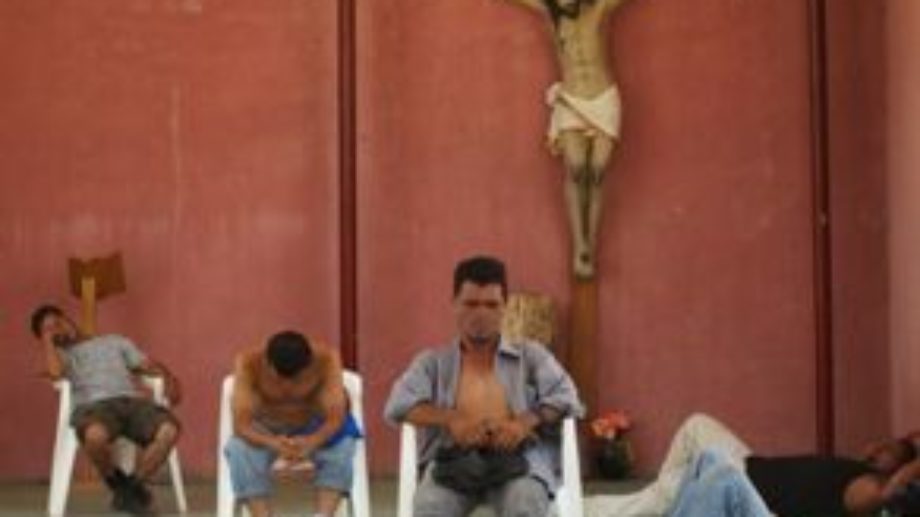
Marc Silver’s Who Is Dayani Cristal?
Ever the hot-button issue and a glaring reminder of dysfunctional government, Critics Academy member Vanessa Erazo take a look at immigration reform through hybrid film Who Is Dayani Cristal? and documentary series How Democracy Works Now, playing at the 51st New York Film Festival.
Just this past Monday, 30 undocumented immigrants who had returned to Mexico (either through deportation or voluntarily) attempted to enter the U.S. through a legal port of entry in Laredo, Texas. Known as the Dream 30, they are young people who grew up in the United States but have no claim to American citizenship. It was an act of protest, wearing caps and gowns they approached the border chanting “Undocumented! Unafraid!”
What inspired such a risky move? Filmmakers Michael Camerini and Shari Robertson have spent almost a decade trying to figure that out. How Democracy Works Now is a documentary project of epic proportions. It is an anthology told in twelve chapters. Each story delves deep into the nitty-gritty details of a herculean task: the attempt to pass comprehensive immigration reform. In the Spotlight on Documentary section the New York Film Festival is showcasing the entire block of completed films. (They’ve finished nine so far.) It’s the first time they are all being screened together.
Similar in theme but completely different in approach is Who Is Dayani Cristal? — another documentary playing at NYFF. The stylized, picturesque, and sometimes hauntingly beautiful film chronicles a mystery of sorts. It traces the identification of a dead body found decomposing in the harsh Sonoran desert not far from Tucson, Arizona. It’s likely the body of a migrant who never made it across the border. Rarely carrying identification in an attempt to conceal their identity immigrants who lose their life in the desert often become nameless statistics. Investigators in Tucson are tasked with solving these cases and are overwhelmed. The coroner explains, “We are knee-deep in border crossing deaths.”
One of the Forensic Anthropologists at the Medical Examiner’s office wonders, “How many deaths does it take to say enough is enough? There’s gotta be some number where someone in Washington says, we can’t have this happen anymore.”
What will it take to pass immigration reform? Migrants crossing the border risk their lives and the Dream 30 are confronting the possibility of being held in detention centers. Why can’t Congress change things? Having watched How Democracy Works Now I finally understood what the hold up was: pure politics.

Michael Camerini and Shari Robertson’s How Democracy Works Now
In Marking Up the Dream, the sixth installment of the series, the Development, Relief and Education of Alien Minors Act, also known as the DREAM Act, is snaking its way through the old, creaky bureaucratic process in the Senate. The bill, first introduced in 2001, offered in-state college tuition and a pathway to legal status for undocumented high school graduates but never passed. In 2009, the DREAM Act was resurrected by its authors. The film follows the bill as it shuttles through the brutal amendment stage at a snail’s pace. (Let’s hope the government shut down doesn’t last as long.)
We are privy to private conversations and back-room deals. It’s as if you are a fly-on-the-wall in a Senator’s office sneakily listening to their congressional aides take frantic calls and broker last minute negotiations. It’s a maddening process to watch. Politicians flip-flop, alliances are broken, and tense conversations are on the verge of boiling over. It’s like Survivor only worse. The future of America is at stake.
After watching the constant back-and-forth and never ending delays the arguments seem futile. How hard is it to come to an agreement on something? Marc Silver — the director of Who Is Dayani Cristal? — thinks Congress is just too far removed from the issue. He says, “It’s easier for politicians to argue when they take the humanity out of it.” His film tries to combat their thinking.
The body found in the desert is of an adult male with a unique tattoo that may help investigators ID him. Scrawled across his chest in curly script are the words “Dayani Cristal.” It’s the story of this one singular person that Silver hopes will illuminate the direct effects of U.S. immigration policy.
While the real-life investigation unfolds, Gael Garcia Bernal, a Mexican actor best known for his roles in the indie hits Amores Perros, Y Tu Mama Tambien, and Motorcycle Diaries retraces the long journey the unidentified man took from his home country of Honduras to the border. It’s a hybrid documentary that blends observational footage with dramatizations of the past and is an insightful companion to How Democracy Works Now.
The countless hours of footage taken by the filmmakers of How Democracy Works Now over the course of ten years still doesn’t have a resolution. And with the federal government in the midst of a complete shut down immigration reform doesn’t seem likely any time soon. Meanwhile, the Dream 30 and other activists continue to take bold steps to push immigration to the forefront of the national conversation. They use civil disobedience to avoid the calls for reform from being drowned out by other hot-button issues. It’s difficult to know what it will take for changes to be made. In how many more years will How Democracy Works Now finally get its fairy-tale ending?



